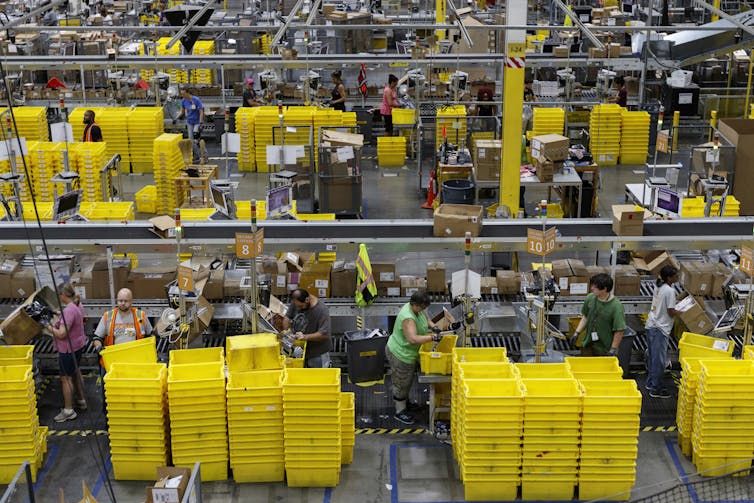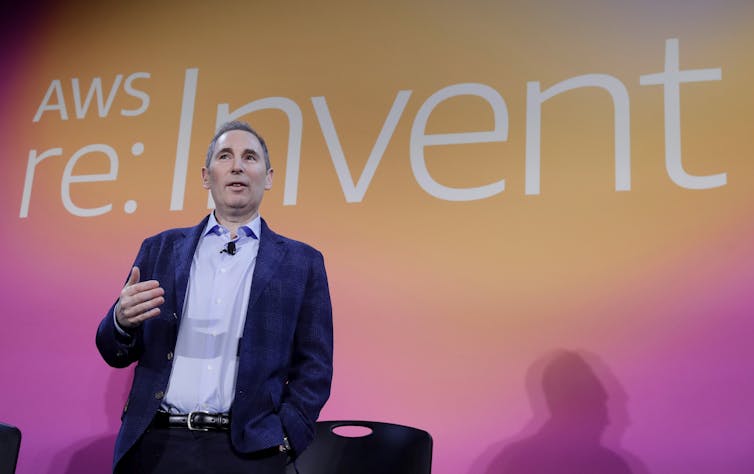What's next for Amazon after Jeff Bezos? No dramatic changes, just more growth and optimisation
- Written by Louise Grimmer, Senior Lecturer in Retail Marketing, University of Tasmania
Jeff Bezos has announced he will stand down as chief executive of Amazon in the third quarter of 2021. The founder of the online retail behemoth will hand the reins to Andy Jassy, who currently leads Amazon’s cloud computing wing.
The announcement comes after an enormously successful 2020 for Amazon despite (or perhaps because of) the COVID-19 pandemic, with operating cashflow up 72% from the previous year to US$66.1 billion, and net sales increasing 35% to US$386.1 billion.
Amazon has its share of detractors, with critics highlighting concerns around working conditions, tax minimisation, anti-competitive practices and privacy. But its enormous size and continuing phenomenal growth make it a force to be reckoned with.
How did Amazon get to this position, and what does the future hold under new leadership?
How it all started
Almost 27 years ago, in 1994, Bezos left his job as a senior vice-president for a hedge fund and started an online bookstore in his garage. At the time, using the internet for retail was in its infancy.
Bezos decided that books were an ideal product to sell online. Originally the new business was named Cadabra, but Bezos soon changed it to Amazon and borrowed US$300,000 from his parents to get things off the ground.
Read more: Amazon is turning 25 – here's a look back at how it changed the world
Books proved popular with growing numbers of online buyers, and Bezos began to add other products and services to the Amazon inventory – most notably e-readers, tablets and other devices. Today Amazon predominantly makes its revenue through retail, web services and subscriptions.
The rise and rise of Amazon
Amazon is now one of the most valuable companies in the world, valued at more than US$1.7 trillion. That’s more than the GDP of all but 10 of the world’s countries. It’s also the largest employer among tech companies by a large margin.
The key to Amazon’s dominance has been constant expansion. After moving into e-readers and tablets, it extended more broadly into technology products and services.
The expansion has not yet stopped, and Amazon’s product lines now include media (books, DVDs, music), kitchen and dining wares, toys and games, fashion, beauty products, gourmet food and groceries, home improvement and gardening, sporting goods, medications and pharmaceuticals, financial services and more.
More recently Amazon has expanded into bricks-and-mortar, heralded by its purchase of the Whole Foods chain in 2017, the creation of its own high tech stores such as Amazon Go, and its sophisticated distribution and delivery services such as Amazon Prime.
Read more: Fear not, shoppers: Amazon's Australian geoblock won't cramp your style
Amazon has become increasingly vertically integrated, meaning it no longer simply sells others’ product but makes and sells its own. This gives the company a position of extreme market dominance.
 Amazon has come under fire over working conditions in its warehouses and shipping centres.
Doug Strickland / AP
Amazon has come under fire over working conditions in its warehouses and shipping centres.
Doug Strickland / AP
Criticism
Amazon is hugely popular with customers, but has attracted criticism from supplier advocates, workers unions and governments.
Industrial relations matters, such as fair wages, unsafe work practices and unrealistic demands, appear the most common area of concern. A 2019 UK report found:
Amazon have no policy on living wage and make no mention of wages being enough to cover workers’ basic needs in their supplier code.
Other concerns relate to alleged unsafe working conditions and “whistleblower” policies.
In March 2020, as COVID-19 began to take hold, workers claimed they were fired for voicing concerns about safe working conditions. Amazon vice president and veteran engineer Tim Bray resigned in solidarity and nine US senators issued an open letter to Bezos, seeking clarity around the sackings.
More general criticisms of the company culture have surfaced over the years, relating to insufficient work breaks, unrealistic demands, and annual “cullings” of the staff – referred to as “purposeful Darwinism”.
Another strand of criticism relates to Amazon’s market size and antitrust laws. Antitrust laws exist to stop big companies creating monopolies. Amazon presents a challenge, as it is a manufacturer, an online retailer, and a marketplace where other retailers can sell products to consumers.
Privacy concerns have also plagued Amazon products like Echo smart speakers, Ring home cameras, and Amazon One palm-scanning ID checkers.
 The Amazon Web Services privacy policy says all the right things.
The Amazon Web Services privacy policy says all the right things.
Read more: Amazon Echo’s privacy issues go way beyond voice recordings
Finally, the amount of company tax Amazon pays in Australia has been brought into question. The company has used a range of tactics to legally reduce the income taxes it pays around the world.
What does the future hold for Amazon in a post-COVID world?
What will change at Amazon when Bezos steps down? We’re unlikely to see a dramatic shift in the short term. For one thing, Bezos is not departing entirely – he will stay involved as “executive chairman”. For another, his successor, Andy Jassy, has been with Amazon since 1997.
Jassy is the head of Amazon Web Services (AWS) and already one of the most important people in the tech industry. AWS has been at the forefront of simplifying computing services, driving the cloud computing revolution and influencing how organisations purchase technology.
 Incoming Amazon CEO Andy Jassy currently heads up Amazon Web Services.
Isaac Brekken / AP
Incoming Amazon CEO Andy Jassy currently heads up Amazon Web Services.
Isaac Brekken / AP
Jassy’s long history, intimate knowledge of the organisation, and technological expertise will no doubt stand Amazon in good stead.
However, he faces a monumental undertaking. Jassy will inherit responsibility for more than a million employees, selling millions of different products and services.
His expertise in AI and machine learning at AWS will be increasingly important as these play a greater role in Amazon’s operations – for everything from optimising warehouses and giving better search results to business forecasting and monitoring warehouse staff and delivery drivers.
The physical lockdowns and online acceleration driven by the COVID-19 pandemic provided the ideal conditions for a company that has been called “the everything store”. Supporters and critics will watch with interest to see if this is still true in a post-COVID environment.
Authors: Louise Grimmer, Senior Lecturer in Retail Marketing, University of Tasmania





